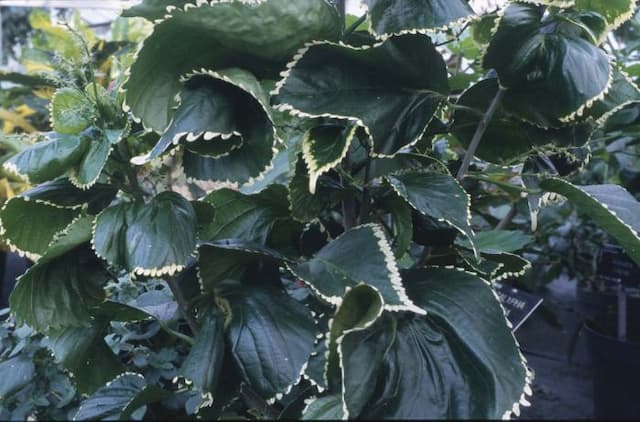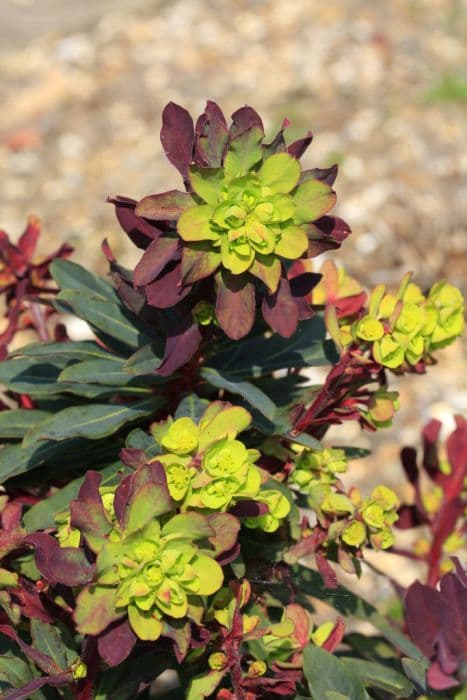Crown of Thorns Euphorbia Excalibur = 'Froeup' (PBR)
![spurge [Excalibur]](/_next/image?url=https%3A%2F%2Fplants-admin.emdemapps.com%2Fimages%2Fplants%2F%2Fimages%2F604b54abe7e39.png&w=3840&q=75)
ABOUT
Euphorbia Excalibur, commonly known as Euphorbia 'Froeup' or Spurge, is characterized by its distinctive and attractive appearance. This plant features a dense, bush-like growth pattern, with numerous stems that create a compact shape. The stems themselves are upright and sturdy, typically boasting a deep green color that provides a lush backdrop for the plant's most striking feature—its leaves. The leaves of the Euphorbia Excalibur are slender and long, with a pointed tip that gives them an almost sword-like appearance, fitting for the plant's Excalibur name. It is their coloration that truly catches the eye; they display a vivid green hue, often with a lighter green to pale yellow edge or variegation, creating a stunning contrast against the darker tones of the stem. During certain times of the year, the leaves may exhibit hints of red or pinkish tones along the margins, adding to the visual interest of the plant. Adding to its ornamental appeal, this variety of Euphorbia produces distinct flowers. The inflorescences, situated at the top of the stems, are made up of small, cup-shaped structures called cyathia. These are typically yellow or green and may have subtle red accents. The tiny, inconspicuous actual flowers are nestled within these cup-like structures, which may go unnoticed without close inspection. However, together they form an eye-catching display that can add a splash of color to the garden. The overall characteristic of the Euphorbia Excalibur's appearance is one of vibrancy and structure, with its foliage providing year-round color and texture to any setting it occupies. Its aesthetic is both graceful and striking, making it a popular choice for gardeners seeking to add an architectural element to their plant compositions.
About this plant
 Names
NamesFamily
Euphorbiaceae.
Synonyms
Excalibur Spurge, Excalibur Euphorbia.
Common names
Euphorbia Excalibur = 'Froeup' (PBR).
 Toxicity
ToxicityTo humans
The common name for Euphorbia Excalibur 'Froeup' (PBR) is spurge. Spurge plants are known for their toxicity to humans due to their milky sap, which contains compounds that can irritate the skin and mucous membranes. If any part of the spurge plant is ingested, it can cause symptoms such as nausea, vomiting, and diarrhea. In severe cases, ingestion can lead to more serious symptoms, including difficulty swallowing, throat swelling, and even anaphylactic reactions in people who are highly sensitive. The most immediate concern after contact with the sap is typically skin and eye irritation, so if sap comes into contact with skin or eyes, it's important to wash the area thoroughly with water and seek medical attention if irritation persists or if any parts of the plant have been ingested.
To pets
The common name for Euphorbia Excalibur 'Froeup' (PBR) is spurge. Spurge is toxic to pets due to its milky sap, which contains irritating and toxic compounds. If a pet ingests any part of a spurge plant, they may show symptoms such as vomiting, diarrhea, drooling, and apparent pain or discomfort. In severe cases, signs may progress to include difficulty breathing or swallowing, significant gastrointestinal upset, and weakness. Contact with the sap can also cause skin and eye irritation. Pet owners should prevent pets from accessing spurge plants and seek immediate veterinary attention if they suspect their pet has ingested any part of the plant.
 Characteristics
CharacteristicsLife cycle
Perennials
Foliage type
Evergreen
Color of leaves
Green
Flower color
Yellow
Height
3 feet (0.91 meters)
Spread
2 feet (0.61 meters)
Plant type
Shrub
Hardiness zones
7
Native area
Cultivar
Benefits
 General Benefits
General Benefits- Low Maintenance: The Euphorbia Excalibur is easy to care for, requiring minimal attention once established.
- Drought Tolerance: This plant is highly drought-resistant, making it ideal for dry climates or water-wise gardens.
- Pest Resistant: It is generally resistant to pests, reducing the need for chemical treatments.
- Unique Appearance: With its striking sword-like foliage, it adds an architectural element to the landscape.
- Long Blooming: It provides a long season of interest with its flowers, often blooming over several months.
- Versatile: The plant is suitable for a variety of garden styles, from rock gardens to contemporary landscapes.
- Deer Resistant: Typically unappealing to deer, it's a good choice for areas with deer pressure.
- Suitability for Pots: Euphorbia Excalibur can be grown in pots, making it versatile for patios and balconies.
- Seasonal Interest: Its evergreen nature ensures visual interest throughout the year.
 Medical Properties
Medical PropertiesThis plant is not used for medical purposes.
 Air-purifying Qualities
Air-purifying QualitiesThis plant is not specifically known for air purifying qualities.
 Other Uses
Other Uses- Euphorbia Excalibur can be used as a natural pest repellent due to the toxic latex it produces, which some pests find unappealing.
- The plant's striking appearance makes it suitable for use in themed gardens, such as a medieval or King Arthur-inspired garden.
- Because of its architectural shape, Euphorbia Excalibur can be used in abstract garden art, providing a green 'sword' element in the design.
- The robust nature of Euphorbia Excalibur allows it to be grown in large containers as a living privacy screen on balconies or patios.
- The plant can serve as an educational tool in botany classes to illustrate the diversity and adaptability of the Euphorbiaceae family.
- Being drought-tolerant, Euphorbia Excalibur can be used in xeriscaping, which is landscaping designed to reduce or eliminate the need for irrigation.
- Dried stems of Euphorbia Excalibur can be used in flower arrangements to add a unique, long-lasting structural element.
- The plant's ability to thrive on neglect makes it a suitable candidate for greening urban spaces with minimal maintenance.
- Euphorbia Excalibur can act as a foil for more colorful plants in a garden, drawing attention to their blooms with its more subdued greenery.
- The latex of the plant can be used experimentally in the making of smaller-scale natural rubber products, though care must be taken due to its potentially irritating properties.
Interesting Facts
 Feng Shui
Feng ShuiThe plant Spurge is not used in Feng Shui practice.
 Zodiac Sign Compitability
Zodiac Sign CompitabilityThe plant Spurge is not used in astrology practice.
 Plant Symbolism
Plant Symbolism- Protection: The name "Excalibur" is reminiscent of the legendary sword of King Arthur, often associated with magical protection and rightful sovereignty. The plant's robustness may symbolize the ability to shield and protect.
- Resilience: Euphorbias are known for their hardiness and ability to thrive in tough conditions. This can symbolize perseverance and resilience in the face of adversity.
- Purification: Some species of Euphorbia are believed to have purifying qualities, possibly due to their sap, which can symbolize cleansing or renewal.
- Healing: Historically, various Euphorbia plants have been used for medicinal purposes, suggesting themes of healing and comfort.
 Water
WaterThe Crown of Thorns, Euphorbia Excalibur 'Froeup,' should be watered sparingly, as it is drought-tolerant and prone to root rot if overwatered. Allow the soil to dry out completely before watering again. Typically, during the growing season, watering every 1 to 2 weeks with about 8-16 ounces depending on the size of the pot should suffice. In winter, reduce watering to once a month or less, since the plant is dormant and uses less water.
 Light
LightCrown of Thorns thrives best in bright, indirect sunlight or partial shade. It prefers a spot that receives a few hours of direct sunlight, especially in the morning, with filtered light throughout the rest of the day. Avoid prolonged exposure to full afternoon sun, which may scorch the leaves.
 Temperature
TemperatureThe Crown of Thorns performs optimally at room temperatures between 60 to 85 degrees Fahrenheit. It can tolerate a minimum temperature of around 50 degrees Fahrenheit, but should not be exposed to temperatures below this for extended periods. Ideal conditions are warm with good circulation and protection from cold drafts.
 Pruning
PruningThe Crown of Thorns benefits from pruning to shape the plant and encourage bushier growth. Prune in the spring or early summer by cutting back leggy growth and removing dead or damaged stems. This should be done cautiously and not too frequently, as the plant is slow-growing and its sap can cause skin irritation.
 Cleaning
CleaningAs needed
 Soil
SoilThe Euphorbia 'Excalibur' thrives best in a soil mix that is well-draining, such as a combination of potting soil, coarse sand, and perlite or pumice. The ideal soil pH for Euphorbia 'Excalibur' should be slightly acidic to neutral, ranging from 6.0 to 7.0. It's crucial to ensure that the soil does not retain moisture to prevent root rot.
 Repotting
RepottingEuphorbia 'Excalibur' should be repotted every two to three years or when it has outgrown its current pot. The best time to do this is during the spring or summer months. When repotting, it is important to use a fresh soil mix as outlined above for optimal plant health and growth.
 Humidity & Misting
Humidity & MistingEuphorbia 'Excalibur' prefers average to low humidity levels, typical of what is found in most homes. Excessive humidity can lead to problems such as rot, so ensuring proper air circulation is key. There is no need to provide additional humidity for this plant.
 Suitable locations
Suitable locationsIndoor
Place in bright, indirect light and well-draining soil.
Outdoor
Grow in full sun to partial shade and well-draining soil.
Hardiness zone
9-11 USDA
 Life cycle
Life cycleThe life of Euphorbia Excalibur, commonly known as Spurge 'Excalibur', begins with seed germination, provided conditions of warmth and light are met. Following sprouting, the seedling stage occurs, where the plant develops its initial roots and leaves. As it enters the vegetative stage, Spurge 'Excalibur' grows more leaves and stems, building up its distinctive structure and foliage. The maturation phase is marked by the development of the plant's characteristic bracts and flowers, typically accompanied by a vibrant change of color. Upon successful pollination, it produces seeds, completing the sexual reproduction cycle. Finally, as it reaches the end of its life span, which may vary widely depending on environmental conditions and care, the plant begins to senesce and eventually dies, freeing up space for new plants to grow.
 Propogation
PropogationPropogation time
Spring-Early Summer
The most popular method for propagating Euphorbia Excalibur, known as 'Froeup' (PBR), is through cutting. During the active growing season, which is typically spring or early summer, take a stem cutting about 4 to 6 inches (approximately 10 to 15 centimeters) long, ensuring that it includes a few leaves. Allow the cut end to dry and callous over for a few days to prevent rot when it is planted. Next, plant the cutting in a well-draining soil mix, just deep enough to support the cutting upright. Water sparingly until roots develop, indicated by new growth, which can take several weeks. Maintaining a warm environment and high humidity can facilitate the rooting process.



![Spurge [Blackbird]](/_next/image?url=https%3A%2F%2Fplants-admin.emdemapps.com%2Fimages%2Fplants%2F%2Fimages%2F604b535f37783.png&w=640&q=75)





